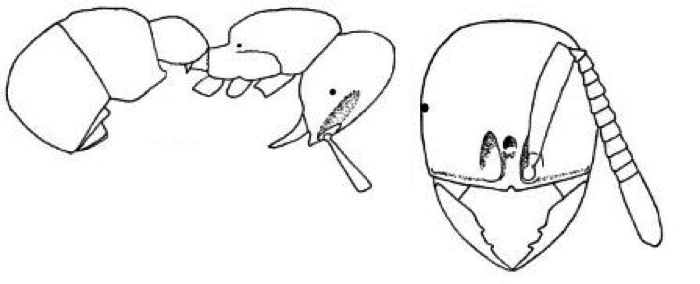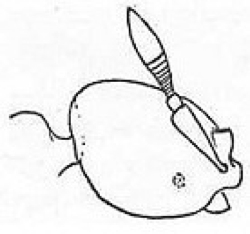SUBFAMILY PROCERATIINAE
| The Ants of
Africa SUBFAMILY PROCERATIINAE |
|
| Contents - Proceratiinae |
Diagnostic Features - Pedicel of a single segment, with a relatively narrow connection to the gaster (the helcium) so that the petiole has a distinct posterior face. Eyes usually present but small; clypeus reduced so that the antennal insertions are close to the anterior margin of the head. Genae usually not carinate. Frontal carinae reduced leaving the antennal insertions uncovered. Pygidium never impressed or armed with spines or denticles. Alitrunk dorsally usually completely fused.
Original status Tribe Proceratii Emery (1895j: 765), type-genus Proceratium
see ![]() . New status as Subfamily by Bolton (2003:
8, 48, 178).
. New status as Subfamily by Bolton (2003:
8, 48, 178).
Escherichia Forel (1910c:245, type species E. brevirostris by monotypy) was reduced to junior synonym of Probolomyrmex by R W Taylor (1965d: 346) who noted - "The single known brevirostris worker is a perfectly typical Probolomyrmex, except for its well developed compund eyes. Separate generic status on the basis of this chracter would be completely unjustified".
Illustrated key to Proceratine genera of Africa - derived in part from Bolton (1994)
| 1 |  Tergite of second gastral
segment strongly arched and vaulted so that the remaining segments
point anteriorly. Sternite of second gastral segment small to minute in
profile, triangular in shape, and with the apex of the triangle
directed ventrally or anteriorly. Eyes present, often small Tergite of second gastral
segment strongly arched and vaulted so that the remaining segments
point anteriorly. Sternite of second gastral segment small to minute in
profile, triangular in shape, and with the apex of the triangle
directed ventrally or anteriorly. Eyes present, often small |
2 |
| -- |  Tergite of second gastral
segment not arched and vaulted, the remaining segments directed
posteriorly. Sternite of second gastral segment large and longitudinal
in profile, subrectangular to trapezoidal in shape. Eyes absent except
in Probolomyrmex brevirostris Tergite of second gastral
segment not arched and vaulted, the remaining segments directed
posteriorly. Sternite of second gastral segment large and longitudinal
in profile, subrectangular to trapezoidal in shape. Eyes absent except
in Probolomyrmex brevirostris |
Probolomyrmex |
| 2 |  Mandible edentate,
overhung by the projecting clypeus. Apical funicular segment strongly
bulbous Mandible edentate,
overhung by the projecting clypeus. Apical funicular segment strongly
bulbous |
Discothyrea |
| -- |  Mandible with 3 or
more teeth, not overhung by the clypeus. Apical funicular segment
moderately enlarged but not strongly bulbous Mandible with 3 or
more teeth, not overhung by the clypeus. Apical funicular segment
moderately enlarged but not strongly bulbous |
Proceratium |
|
© 2007, 2012 - Brian Taylor CBiol FSB FRES 11, Grazingfield, Wilford, Nottingham, NG11 7FN, U.K. |
href="proceratiinae.htm"